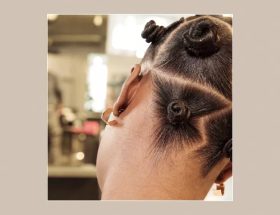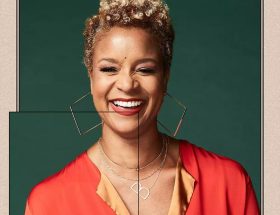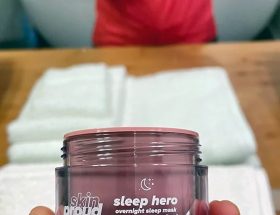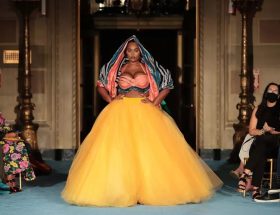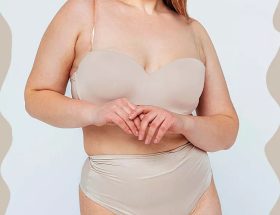How to Protect Your Curls Against Heat This Silk Press Season
chunky sweaters, pumpkin spice everything, and seasonal decor are signs that fall is in full swing. When cooler temps and crisp leaves roll around, you can also expect a shift in hairstyles. Warmer colors like reds and browns are indicators that autumn has commenced, and for women with natural hair, it also presents a spike in silk press season.
Though there’s no right or wrong time for a silk press, summer makes it challenging because sweat and straightened natural hair don’t always mesh. It’s why there’s no better time to pause on protective styling, to try a straight style. Plus, the possibilities of buns, chunky braids, and waves make a silk press seem worth it.
Still, heat-styling natural hair is a double-edged sword of sorts. Over the years, it’s been more embraced as we learn more about protecting our curls from damage, but there’s a fine line. Hot tools can permanently change your curl pattern and texture, and without a few precautions, they can end being detrimental to your overall hair health.
However, the good news is thanks to tons of knowledge and innovation, there are many solutions to keep your hair healthy while straight. To help before your next salon appointment, we tapped top stylists to share their tips for protecting your curls from heat this season. Read ahead for more.
Kim Kimble is a celebrity hairstylist who has worked with the likes of Beyoncé, Kerry Washington, Mary J. Blige, and more. She’s also the founder of her bespoke natural hair product line.
Angela Stevens is an Emmy award-winning hairstylist and Cantu Beauty brand ambassador.
Araxi Lindsey is an Emmy winner, celebrity hairstylist, and hair creator of Black-Ish.
Kayleena Johnson is a braid stylist and natural hair expert at Beautybeez.
Prep (And Products) Are Important
Kim Kimble has styled many of Hollywood’s hottest celebrities, and her bottom line rule is setting a healthy foundation to protect your hair. “Protecting your hair from heat damage is very important, and it all starts with your shampoo and conditioner,” Kimble says. “You want to make sure that your scalp and hair are healthy, and having a moisturizing and protecting shampoo and conditioner can help. “Kimble recommends her bespoke Rephair shampoo and conditioner to help cleanse and replenish the hair, followed by a leave-in conditioner for added moisture.
In addition to proper cleansing, conditioning is also a critical step, according to Kimble. “Conditioning treatments, such as masks, can repair, moisturize and replenish your hair,” she says. “I suggest using the Star Treatment Masque from my line at Walmart paired with a steamer to really lock in moisture.” Angela Stevens recommends the Cantu Deep Treatment Masque for added moisture on freshly washed hair. According to Johnson, in addition to keeping your hair healthy, a deep treatment can also result in a better-looking style.
“Deep conditioning improves your hair’s elasticity and ensures that the hair cuticle is sealed for a sleeker look,” she explains.
Both Stevens and Kimble agree that a good heat protectant is critical to keeping your hair healthy in the heat-styling process, and Stevens says to be sure your hair is clean, dry, and oil-free before using a hot tool. “Let your hair air dry, and spray it with a heat protectant like Cantu Thermal Shield Heat Protectant to maintain moisture,” she explains. “Using heat should only be done on clean, oil-free hair. Damage can arise from applying heat to hair with oil and product buildup because it fry the hair.”
It may feel instinctual to pass just any flat iron or blow dryer through your hair, but you should be selective with your hot tools. “If you are going to use hot tools, make sure you are using high-quality products that won’t burn your hair,” Kimble explains. “Look for tourmaline ceramic.” Johnson swears by Babyliss Pro and Dyson tools for styling natural hair. “Dyson can be a bit pricey, but it’s important to invest in quality heat tools to minimize any chance of damage,” she explains.
Stevens also says to avoid using hot tools at their highest temperature to prevent burning and excess moisture loss. “Instead, set it at the lowest temperature and apply the heating tool for no longer than ten seconds apart to prevent hair damage,” she explains. Lindsey’s quick hack is to count to three while the hot tool is in motion, so it doesn’t stay in one place [on your hair] for too long.
Lindsey also says to avoid using professional tools at home. “Most professional tools and products come with instructions, or certain techniques only a licensed cosmetologist is skillfully trained in,” she says. “I would recommend visiting a professional cosmetologist at least every six to eight weeks for trims and hair treatments.”
While prepping your hair is critical in preserving the health of your strands, what you do after your style is equally important. Lindsey says that one of her go-to methods for preserving the integrity of her hair is to wrap it in silk scarves when possible and sleeping with a silk pillowcase. “This will help prevent your hair snagging on cotton, polyester, or any other fabric that isn’t smooth,” she explains. “Silk also helps retain moisture in the hair.” Kimble also recommends tying your hair up with a silk bonnet and recommends her namesake one to keep your strands—no matter the style— intact.



